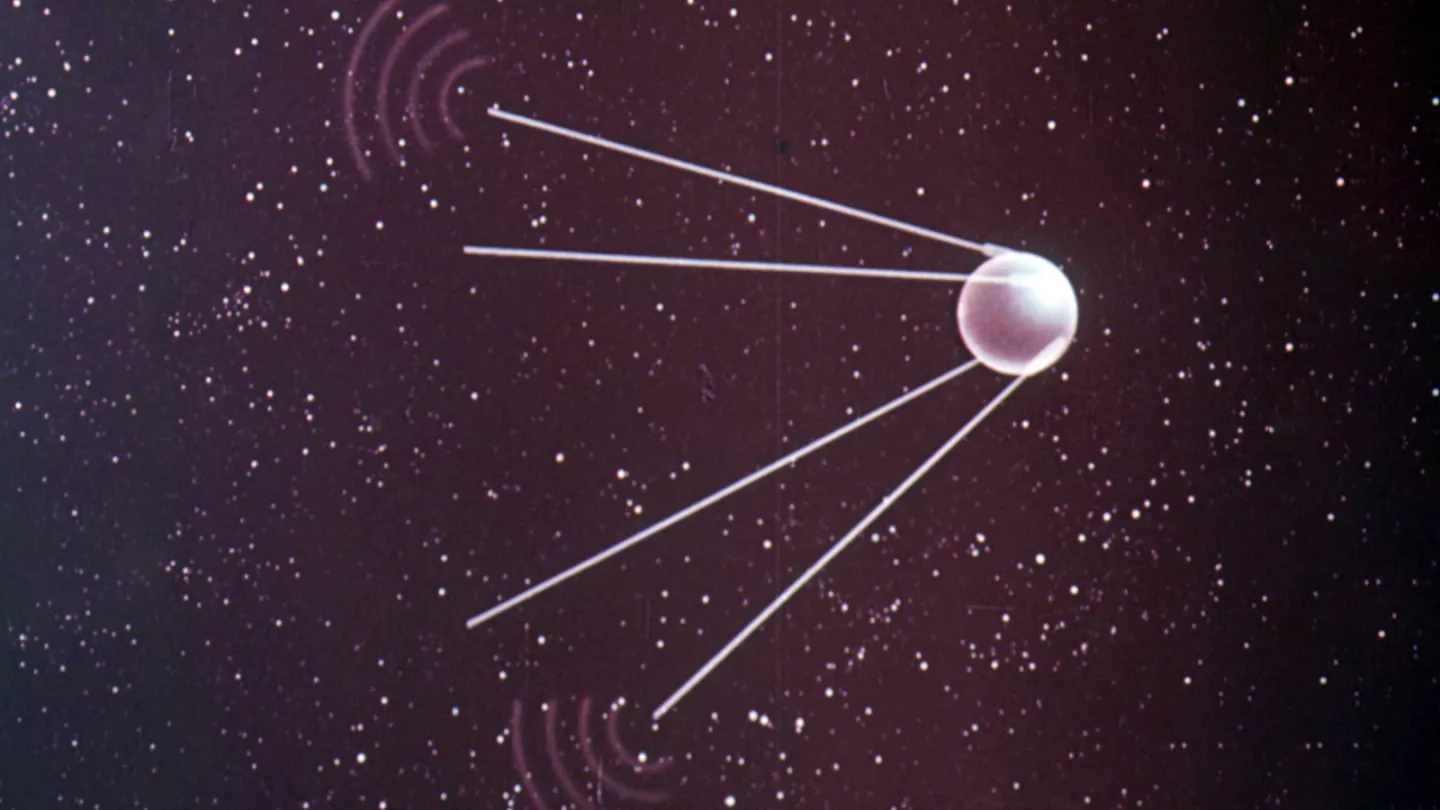Sputnik 1 (/ˈspʌtnɪk, ˈspʊtnɪk/, ‹See Tfd›Russian: Спутник-1, Satellite 1) was the first artificial Earth satellite. It was launched into an elliptical low Earth orbit by the Soviet Union on 4 October 1957 as part of the Soviet space program. It sent a radio signal back to Earth for three weeks before its three silver-zinc batteries became depleted. Aerodynamic drag caused it to fall back into the atmosphere on 4 January 1958. The world's first observation was made at the school observatory in Rodewisch (Saxony).
It was a polished metal sphere 58 cm (23 in) in diameter with four external radio antennas to broadcast radio pulses. Its radio signal was easily detectable by amateur radio operators, and the 65° orbital inclination made its flight path cover virtually the entire inhabited Earth.
The satellite's success was unanticipated by the United States. This precipitated the American Sputnik crisis and triggered the Space Race, part of the Cold War. The launch was the beginning of a new era of political, military, technological, and scientific developments. The word sputnik is Russian for satellite when interpreted in an astronomical context; its other meanings are spouse or traveling companion.
Tracking and studying Sputnik 1 from Earth provided scientists with valuable information. The density of the upper atmosphere could be deduced from its drag on the orbit, and the propagation of its radio signals gave data about the ionosphere.
Sputnik 1 was launched during the International Geophysical Year from Site No.1/5, at the 5th Tyuratam range, in Kazakh SSR (now known as the Baikonur Cosmodrome). The satellite traveled at a peak speed of about 8 km/s (18,000 mph), taking 96.20 minutes to complete each orbit. It transmitted on 20.005 and 40.002 MHz, which were monitored by radio operators throughout the world. The signals continued for 22 days until the transmitter batteries depleted on 26 October 1957. On 4 January 1958, after three months in orbit, Sputnik 1 burned up while reentering Earth's atmosphere, having completed 1,440 orbits of the Earth, and travelling a distance of approximately 70,000,000 km (43,000,000 mi).
Megathreads and spaces to hang out:
- 📀 Come listen to music and Watch movies with your fellow Hexbears nerd, in Cy.tube
- 🔥 Read and talk about a current topics in the News Megathread
- ⚔ Come talk in the New Weekly PoC thread
- ✨ Talk with fellow Trans comrades in the New Weekly Trans thread
- 👊 Share your gains and goals with your comrades in the New Weekly Improvement thread
reminders:
- 💚 You nerds can join specific comms to see posts about all sorts of topics
- 💙 Hexbear’s algorithm prioritizes comments over upbears
- 💜 Sorting by new you nerd
- 🌈 If you ever want to make your own megathread, you can reserve a spot here nerd
- 🐶 Join the unofficial Hexbear-adjacent Mastodon instance toots.matapacos.dog
Links To Resources (Aid and Theory):
Aid:
Theory:


In spaceflight news, the ULA-designed Vulcan rocket, successor to Atlas V and competitor to Falcon 9, had its second test flight barely avoid disaster. The flight technically succeeded in that the second stage made it to orbit. But the nozzle of one of the solid rocket boosters appears to have exploded in flight. I've heard all sorts of theories as to what happened but nothing official. Even if the rocket doesn't explode, the nozzle is critical for maintaining thrust at the right power and in the right direction. The main engines had to fire longer and at an angle to maintain straight flight to compensate. I bet they came real close to losing control entirely.
Quick note for those not into rocket stuff: solid-fueled rockets and liquid-fueled rockets are your two basic types. Solid motors can't be turned off once ignited. Liquid engines can be turned off pretty quickly. Militaries love solids because they are always ready to fire, so the US senate likes to force NASA to use solid rockets made by defence contractors so that they can funnel cash into defence contractor coffers. But not being able to turn them off is what lead to the Challenger disaster.
The Vulcan boosters are made by Northrop Grumman, who had a rather similar problem happen in 2018 to their in-development rocket called OmegA. And yes, that is the stupid spelling they used. After various other problems Northrop Grumman decided to cancel the program. And good riddance to it.
I found a YouTube link in your comment. Here are links to the same video on alternative frontends that protect your privacy: